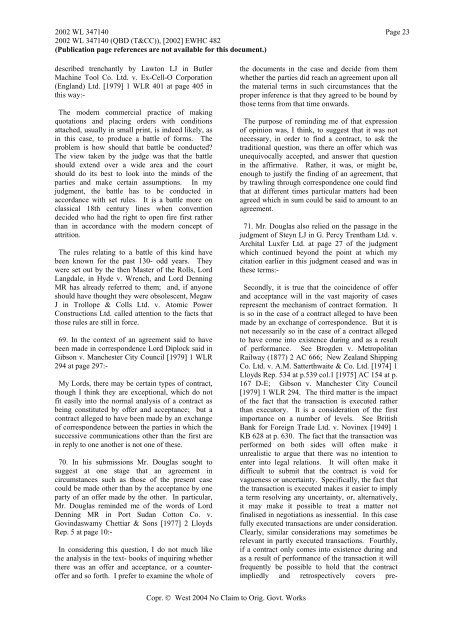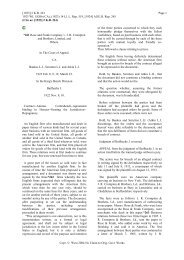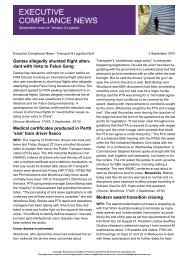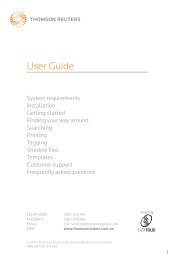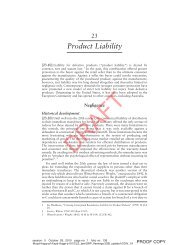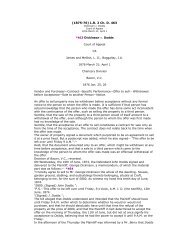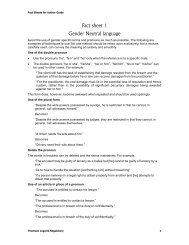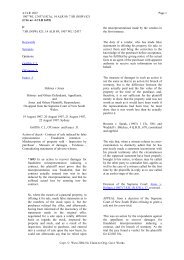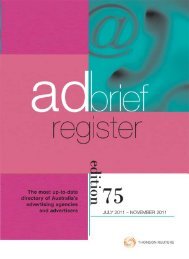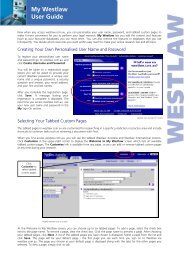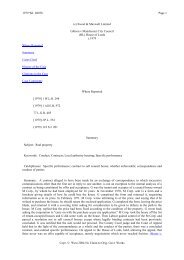Tesco v Constain - Thomson Reuters
Tesco v Constain - Thomson Reuters
Tesco v Constain - Thomson Reuters
Create successful ePaper yourself
Turn your PDF publications into a flip-book with our unique Google optimized e-Paper software.
2002 WL 347140 Page 232002 WL 347140 (QBD (T&CC)), [2002] EWHC 482(Publication page references are not available for this document.)described trenchantly by Lawton LJ in ButlerMachine Tool Co. Ltd. v. Ex-Cell-O Corporation(England) Ltd. [1979] 1 WLR 401 at page 405 inthis way:-The modern commercial practice of makingquotations and placing orders with conditionsattached, usually in small print, is indeed likely, asin this case, to produce a battle of forms. Theproblem is how should that battle be conducted?The view taken by the judge was that the battleshould extend over a wide area and the courtshould do its best to look into the minds of theparties and make certain assumptions. In myjudgment, the battle has to be conducted inaccordance with set rules. It is a battle more onclassical 18th century lines when conventiondecided who had the right to open fire first ratherthan in accordance with the modern concept ofattrition.The rules relating to a battle of this kind havebeen known for the past 130- odd years. Theywere set out by the then Master of the Rolls, LordLangdale, in Hyde v. Wrench, and Lord DenningMR has already referred to them; and, if anyoneshould have thought they were obsolescent, MegawJ in Trollope & Colls Ltd. v. Atomic PowerConstructions Ltd. called attention to the facts thatthose rules are still in force.69. In the context of an agreement said to havebeen made in correspondence Lord Diplock said inGibson v. Manchester City Council [1979] 1 WLR294 at page 297:-My Lords, there may be certain types of contract,though I think they are exceptional, which do notfit easily into the normal analysis of a contract asbeing constituted by offer and acceptance; but acontract alleged to have been made by an exchangeof correspondence between the parties in which thesuccessive communications other than the first arein reply to one another is not one of these.70. In his submissions Mr. Douglas sought tosuggest at one stage that an agreement incircumstances such as those of the present casecould be made other than by the acceptance by oneparty of an offer made by the other. In particular,Mr. Douglas reminded me of the words of LordDenning MR in Port Sudan Cotton Co. v.Govindaswamy Chettiar & Sons [1977] 2 LloydsRep. 5 at page 10:-In considering this question, I do not much likethe analysis in the text- books of inquiring whetherthere was an offer and acceptance, or a counterofferand so forth. I prefer to examine the whole ofthe documents in the case and decide from themwhether the parties did reach an agreement upon allthe material terms in such circumstances that theproper inference is that they agreed to be bound bythose terms from that time onwards.The purpose of reminding me of that expressionof opinion was, I think, to suggest that it was notnecessary, in order to find a contract, to ask thetraditional question, was there an offer which wasunequivocally accepted, and answer that questionin the affirmative. Rather, it was, or might be,enough to justify the finding of an agreement, thatby trawling through correspondence one could findthat at different times particular matters had beenagreed which in sum could be said to amount to anagreement.71. Mr. Douglas also relied on the passage in thejudgment of Steyn LJ in G. Percy Trentham Ltd. v.Archital Luxfer Ltd. at page 27 of the judgmentwhich continued beyond the point at which mycitation earlier in this judgment ceased and was inthese terms:-Secondly, it is true that the coincidence of offerand acceptance will in the vast majority of casesrepresent the mechanism of contract formation. Itis so in the case of a contract alleged to have beenmade by an exchange of correspondence. But it isnot necessarily so in the case of a contract allegedto have come into existence during and as a resultof performance. See Brogden v. MetropolitanRailway (1877) 2 AC 666; New Zealand ShippingCo. Ltd. v. A.M. Satterthwaite & Co. Ltd. [1974] 1Lloyds Rep. 534 at p.539 col.1 [1975] AC 154 at p.167 D-E; Gibson v. Manchester City Council[1979] 1 WLR 294. The third matter is the impactof the fact that the transaction is executed ratherthan executory. It is a consideration of the firstimportance on a number of levels. See BritishBank for Foreign Trade Ltd. v. Novinex [1949] 1KB 628 at p. 630. The fact that the transaction wasperformed on both sides will often make itunrealistic to argue that there was no intention toenter into legal relations. It will often make itdifficult to submit that the contract is void forvagueness or uncertainty. Specifically, the fact thatthe transaction is executed makes it easier to implya term resolving any uncertainty, or, alternatively,it may make it possible to treat a matter notfinalised in negotiations as inessential. In this casefully executed transactions are under consideration.Clearly, similar considerations may sometimes berelevant in partly executed transactions. Fourthly,if a contract only comes into existence during andas a result of performance of the transaction it willfrequently be possible to hold that the contractimpliedly and retrospectively covers pre-Copr. © West 2004 No Claim to Orig. Govt. Works


